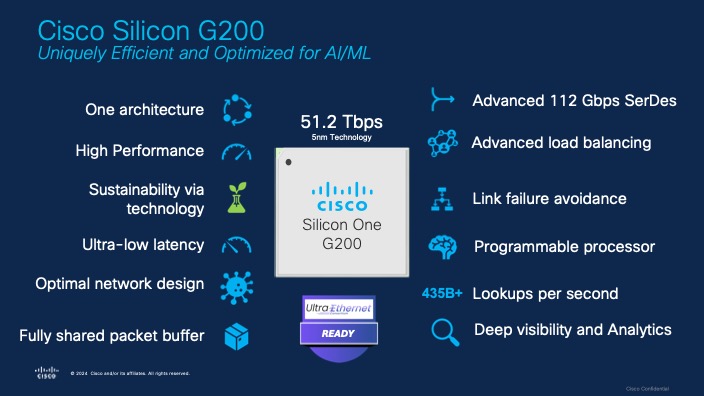- I found 73 of the best Amazon Spring Sale TV deals from Samsung, TCL, Bose, and more
- Why Eliminating the Cyber Safety Review Board Weakens Critical Infrastructure and Cyber Resilience
- With AI models clobbering every benchmark, it's time for human evaluation
- My $8 secret to keeping my DIY electronic repairs sealed and secured
- This 85-inch TV deal at $1,100 off made me reconsider paying up for OLED
Supercharge Your AI Data Center Infrastructure with New Cisco Nexus 9000 Series Switches

The exponential growth of AI is reshaping data center requirements, driving demand for scalable, secure, and programmable networks. Enterprise customers are evaluating their current infrastructure to support rapid AI deployment and scalability, often upgrading to be AI-ready and securing workload communications such as GPU or CPU. This shift requires integrating AI-ready networking with distributed security policies as users, applications, and data span public and private clouds, colocation centers and more. Our customers are using Cisco Nexus 9000 Series Switches to run AI/ML workloads today over 400G network infrastructure. With generative AI adding complexity, we are seeing the customer need for a simple and secure infrastructure for performance monitoring and security across diverse environments, with 800G-based design plans in many data center buildouts.
Leveraging Cisco Silicon One G200, Cisco Nexus 9000 Series Switches are engineered to meet these demands with high-density 800G fabrics (see Figure 1) —making them ideal for next-generation leaf-and-spine network designs for cloud architecture, high-performance computing (HPC), and large-scale AI/ML workloads (see Figure 2). For example, Cisco Silicon One G200 uses advanced load balancing and fault detection to help improve job completion times (JCTs) for AI/ML workloads.

With the Cisco Nexus 9364E-SG2 switches, we are introducing high-density 800G aggregation for data center fabrics (see Figure 3). Support for numerous port speeds and densities include 400, 200, and 100 Gbps, and both OSFP and QSFP-DD form factors.

Figure 3: Cisco Nexus 9364E-SG2 switch
When combined with tools like Cisco Nexus Dashboard for visibility and automation, Cisco Nexus 9000 Series Switches offer the efficient management, troubleshooting, and in-depth analysis required by large cloud and data center networking teams.
Architectural flexibility: Cisco Nexus 9000 Series Switches support a wide range of protocols and architectures, including VXLAN EVPN, Cisco IP Fabric for Media (IPFM), and IP-routed Ethernet-switched fabrics. This flexibility ensures that businesses can adapt their network infrastructure to meet evolving needs without requiring significant overhauls.
Extensive programmability: The switches can drastically reduce provisioning time and enhance network observability with features like Day-0 automation through PowerOn Auto Provisioning (POAP) and industry-leading integrations for DevOps configuration management applications (such as Ansible). This level of programmability allows businesses to streamline operations and improve efficiency.
AI/ML Networking: Cisco Nexus 9000 Series Switches support innovative congestion management and flow control algorithms along with the right latency and telemetry to meet the design requirements of AI/ML fabrics.
- Dynamic Load Balancing (DLB) distributes traffic across multiple paths or links that have the same cost in terms of routing metrics
- Priority Flow Control (PFC) that prevents Ethernet frame drops by signaling, controlling, and managing Ethernet flows along a path by sending pause frames to appropriate senders
- Explicit Congestion Notification (ECN) provides end-to-end notification per IP flow by marking packets that experienced congestion, without dropping traffic
- Lossless transport for Remote Direct Memory Access (RDMA) over Converged Ethernet (RoCE) with support of Data-Center-Bridging (DCB) protocols
High availability: With features like virtual port channel (vPC) technology, Software Maintenance Upgrades (SMUs), and In-Service Software Upgrades (ISSUs), Cisco Nexus 9000 Series Switches ensure high availability and minimal downtime. This reliability is essential for businesses that require continuous network operation.
Simplified operations: By using Cisco Nexus Dashboard with Cisco Nexus 9000 Series Switches, data center network operations can be transformed through simplicity, automation, and AI analytics. Cisco Nexus Dashboard helps customers efficiently manage and operate data center networks, including with comprehensive visibility and control, that enables businesses to effectively optimize their network infrastructure.
Flexible licensing: The Cisco Nexus 9364E-SG2 switch utilizes Cisco standard licensing model, which includes Premier, Advantage, and Essentials options. This flexible licensing model allows businesses to choose the licensing that best suits their immediate needs, while still offering the ability to scale and unlock more advanced features as they grow.
Driving business outcomes with advanced features:
Cisco Nexus 9000 Series Switches offer a robust, scalable, and flexible solution for modern data centers, driving significant business outcomes through enhanced performance, reliability, and efficiency. Key innovations include:
- 256MB fully shared packet buffer: consistent and predictable traffic performance with enhanced burst absorption and fewer dropped packets helps improve overall network resiliency.
- 512 radix: scaling out larger clusters helps maximize bandwidth, reduce costs with fewer switches, and consume energy more efficiently.
The Cisco Nexus 9000 Series Switches are UEC-ready, fully complying with Ultra Ethernet Consortium (UEC) fabric baseline requirements such as PFC, ECN, and multiple traffic classes, to help ensure robust performance for AI Ethernet networks. Additionally, the programmability of the Silicon One architecture ensures future proofing, enabling the switches to adapt to evolving UEC standards while delivering consistent high performance and scalability, allowing businesses to seamlessly advance their AI/ML infrastructure.
Through major investments across silicon, systems, software, and optics, Cisco has the knowledge, expertise, and integration capabilities to deliver what customers need.
Whether you are looking to support AI/ML workloads or modernize your network infrastructure, we can provide the tools and capabilities needed to improve customer outcomes with Cisco Nexus 9000 Series Switches.
Learn more at the Open Compute Project event (October 15–17) Community Lounge. Interested customers can schedule a demo here.
Share:

